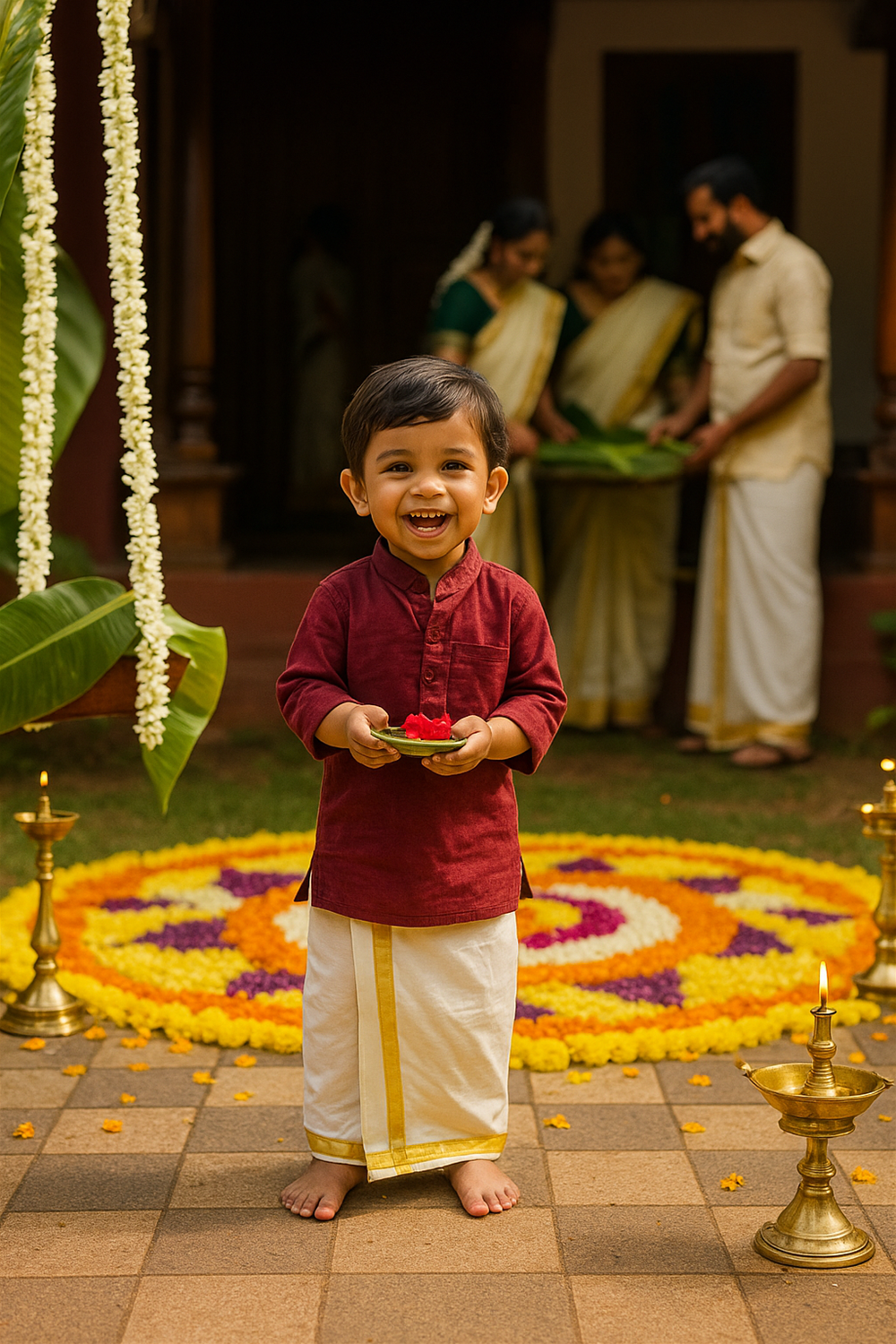
27456 Boys Linen Cotton Maroon color Kurtha in Full Sleeve
Send With EMS Speed Post
Flexible returns
The boy wears a maroon cotton kurta with a Mandarin collar, chest pocket, and side slits, paired with a white dhoti featuring a golden zari border. Barefoot and holding a plate of red flowers, he stands against a festive backdrop of pookalam, lamps, and traditional Kerala décor. This South Indian ensemble blends comfort, elegance, and cultural symbolism, making it ideal for occasions like Onam, Vishu, and temple celebrations.
-
Traditional South Indian Festive Ensemble
The boy is dressed in a classic South Indian outfit typically worn during cultural celebrations and festivals like Onam or Vishu. The attire consists of a maroon kurta paired with a pristine white dhoti (veshti/mundu) accented by a golden zari border, reflecting regional heritage and traditional elegance. -
Maroon Kurta – Rich and Regal Color Choice
The upper garment is a deep maroon kurta, a color often associated with festivity, richness, and auspiciousness. This hue stands out beautifully against the white dhoti, creating a striking and balanced visual contrast that is both culturally significant and photogenic. -
Kurta Fabric and Texture
The kurta is likely made from a soft, breathable cotton or a cotton-linen blend, ensuring comfort during warm festival days. The fabric appears matte with a subtle weave, avoiding any flashy sheen while maintaining a premium finish. -
Mandarin Collar Design
The kurta features a Mandarin (band) collar, which gives it a structured neckline while retaining traditional aesthetics. This style is neat and formal yet comfortable for children, eliminating the bulk of a fold-over collar. -
Short Placket with Wooden-Style Buttons
The front of the kurta has a short placket with 2–3 buttons, probably in a wooden or brown tone to complement the maroon fabric. This not only adds a decorative element but also makes dressing easier for the child. -
Left-Side Chest Pocket
A single pocket on the left chest serves both style and function. While decorative in nature for this occasion, it could hold a tiny handkerchief or be used for practical purposes during other events. -
Full-Length Sleeves
The kurta is designed with full-length sleeves, a common choice for festive wear, lending the outfit a more formal and ceremonial appeal. The sleeves are relaxed, ensuring free arm movement for active children. -
Straight Hemline with Side Slits
The hem of the kurta is straight with small side slits, aiding in comfort and ease of movement—especially important for children running around during celebrations. -
Traditional White Dhoti (Veshti/Mundu)
The lower garment is a child-sized version of the traditional South Indian dhoti, known locally as veshti (Tamil) or mundu (Malayalam). It is crisp white, symbolizing purity and auspiciousness. -
Golden Zari Border on Dhoti
The dhoti is adorned with a lustrous golden zari border along the edges. This shimmering trim adds a festive and luxurious touch, catching the light beautifully and enhancing the ceremonial look. -
Perfectly Draped Fit for a Child
The dhoti is proportionately draped for a young child, reaching the ankles for a neat silhouette. The length allows comfortable walking while maintaining the dignity of the traditional style. -
Barefoot Tradition
The boy is barefoot, a common and culturally significant choice during traditional ceremonies, especially in temple or home settings. It symbolizes respect, humility, and spiritual cleanliness. -
Cultural Accessory – Plate with Flowers
In his hands, the boy holds a small brass or metal plate with red flowers—likely for offering during a ritual. This small detail enhances the authenticity of the festive atmosphere. -
Festive Setting Complementing the Attire
The attire harmonizes perfectly with the festive backdrop—pookalam (floral rangoli) in vibrant yellow, orange, white, and purple, surrounded by brass oil lamps and traditional Kerala décor elements like banana leaves and jasmine garlands. -
Symbolism of the Outfit
The combination of maroon and white with golden accents signifies joy, prosperity, and auspicious beginnings. For a child, such attire not only carries cultural pride but also introduces them to the values and traditions of their heritage in a tangible way.


